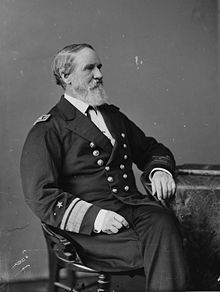Thornton A. Jenkins: Difference between revisions
FieldMarine (talk | contribs) removed Category:United States Navy admirals; added Category:United States Navy rear admirals using HotCat |
Saxophobia (talk | contribs) mNo edit summary |
||
| Line 52: | Line 52: | ||
* Two destroyers of the [[United States Navy]] have been named {{USS|Jenkins}} in his honor. |
* Two destroyers of the [[United States Navy]] have been named {{USS|Jenkins}} in his honor. |
||
* His grandson, [[Thornton Jenkins Hains]], a novelist and murder suspect. |
* His grandson, [[Thornton Jenkins Hains]], a novelist and murder suspect. |
||
* Father-In-Law of Florence Foster Jenkins |
|||
==References== |
==References== |
||
Revision as of 15:11, 27 September 2021
Thornton Alexander Jenkins | |
|---|---|
Thornton Jenkins | |
| Born | 11 December 1811 Orange Court House, Virginia |
| Died | 9 August 1893 (aged 81) |
| Place of burial | |
| Allegiance | |
| Service | United States Navy |
| Years of service | 1828–1873 |
| Rank | |
| Commands | |
| Battles / wars | |
Thornton A. Jenkins (11 December 1811 – 9 August 1893) was an officer in the United States Navy, who served during the Mexican–American War and the American Civil War. He later served as chief of the Bureau of Navigation and as president of the United States Naval Institute. Jenkins retired as a rear admiral.
Early life and career
Born at Orange Court House, Virginia, Jenkins entered the Navy as a midshipman on 1 November 1828, and served first in the West Indies in an expedition against pirates and slavers. Examined for a commission as lieutenant, he placed first among 82 candidates. In 1831 Jenkins helped to suppress Nat Turner's slave rebellion.
Prior to the Mexican–American War, Jenkins served with the Coast Survey and with the Brazilian and Mediterranean Squadrons. During the war with Mexico, as executive officer of Germantown, he led landing parties from his ship at Tuxpan and Tabasco. Later, he commanded the store-ship Relief and the supply station at Salmedena Island. In the interval between the wars, he served in the receiving ship at Baltimore, returned to the Coast Survey, and was secretary of the Lighthouse Board.
Civil War service

His Civil War record was distinguished. In 1861 Jenkins performed secret services for President Lincoln, until he became ill in 1861. After this, Jenkins became a captain and served primarily in the West Gulf Blockading Squadron of David Farragut, he commanded Oneida. He served as chief of staff to Farragut, and was later wounded while commanding a convoy escort group. As senior officer present, in command of Richmond, he received the surrender of Port Hudson on 9 July 1863. Admiral Farragut had temporarily gone to New Orleans on business at the time. Jenkins later commanded a division of the squadron. He was present at the Battle of Mobile Bay and heard Farragut utter the famous line "Damn the torpedoes, full speed ahead." Though, according to Thornton, what Farragut actually said was "Go ahead sir and damn the torpedoes!"[1]
Postwar activities
Jenkins was chief of the Bureau of Navigation, from 1865 to 1869. He became a real admiral in 1870 and commanded the Asiatic Squadron from 1870 until his retirement in 1873. Rear Admiral Jenkins was president of the Naval Institute from 1883 to 1885, and died on 9 August 1893. Jenkins was buried at Arlington National Cemetery.[2]
Namesakes
- Two destroyers of the United States Navy have been named USS Jenkins in his honor.
- His grandson, Thornton Jenkins Hains, a novelist and murder suspect.
- Father-In-Law of Florence Foster Jenkins
References
- ^ "The Battle of Mobile Bay". The Washington Post. 25 April 1881.
- ^ Burial Detail: Jenkins, Thornton A (section 1, grave 43-C-D) – ANC Explorer
- Marshall, Amy K., Frequently Close to the Point of Peril : A History of Buoys and Tenders in U.S. Coastal Waters, 1789–1939. April 1997. Thesis, Master of Arts in Maritime History/Nautical Archaeology, East Carolina University. Online. December 1999. U.S. Coast Guard. Viewed 1 March 2006.
 This article incorporates text from the public domain Dictionary of American Naval Fighting Ships. The entry can be found here.
This article incorporates text from the public domain Dictionary of American Naval Fighting Ships. The entry can be found here.
External links
- Destroyer History Foundation – Rear Admiral Thornton A. Jenkins, namesake of USS Jenkins (DD-447; later DDE-447)
- Thornton A. Jenkins at ArlingtonCemetery•net, an unofficial website
